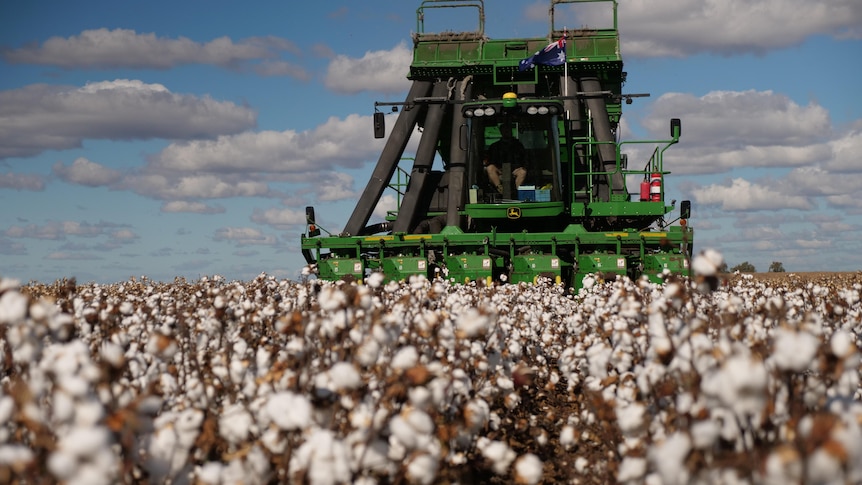
VANGUARD - Expressing the viewpoint of the Communist Party of Australia (Marxist-Leninist)
For National Independence and Socialism • www.cpaml.org
(Above: Photo source ABC Rural Jon Daly)
Cotton has been grown in Australia since the late nineteenth century. Cotton growing started to take off in the 1960s with trials of cotton growing in the Murrumbidgee area. Today there are about 1500 cotton farms, mainly in New South Wales and Queensland.
In recent years an increasing amount of cotton has also been grown in the Northern Territory. Strong concerns have been expressed by First Nations peoples and environmentalists about the amount of land being cleared for cotton growing and the amount of water cotton growing will require.
Ninety per cent of cotton farms are family farms producing eighty per cent of the crop. The rest are corporate farms owned by Australian and foreign companies, mainly Canadian, Dutch, Singapore and Chinese interests.
The Bureau of Agricultural and Resource Economics and Sciences (ABARES) estimates that for 2022-23 the value of Australia’s cotton industry will be $2.6 billion. While this is a lot less than other industries such as horticulture, grains, beef and wool, the cotton industry is still attractive to investors.
Canadian Superannuation fund PSP has been buying up big in Australian cotton growing farms and processing plants, including a purchase of Austcott’s farming and ginning business. Recently the Chinese shirt manufacturer Smart Shirts Limited, (part of the $20 billion Youngor Group), paid S120 million for one of Australia’s biggest cotton properties in the Riverina. In 2022 an investment fund run by the Macquarie bank acquired 100% of Cubbie Station, (Australia’s biggest cotton farm), by buying out its Chinese partner in the enterprise.
Cotton is grown from seeds planted in spring .The seeds grow into a bush about one metre high which develops fruit known as bolls which contain fluffy white lint and cotton seeds. In summer these are harvested mechanically and transported to a processing plant known as a gin. Here the lint is separated from the seeds and pressed into 227 kg bales.
Because cotton spinning in Australia is almost non-existent, ninety-nine per cent of Australia’s cotton is exported to countries such as China, India, Vietnam and Bangladesh to be made into clothing, manchester and other cotton products to be re-exported to Australia.
About three-quarters of Australia’s cotton gins are owned by foreign companies such as PSP (Canada), OLAM (Singapore) and Louis Dreyfus (Netherlands). This industry is worth about $1700 million per year, so it is also very attractive to foreign players.
Cotton and Water Use
Cotton is a thirsty crop, requiring about 6-7 megalitres of water per hectare. (Rice is even thirstier, requiring 11.5 ml/ha. Fruit and nut trees require 5.1 ml/ha.) It takes about 10,000 litres of water to produce one kilogram of cotton, or 2700 litres to make one T-shirt!
About one third of Australia’s crop is rain grown, the rest requires water from irrigation. Cotton Australia, the peak body for cotton growers in Australia claims that there has been a 48% increase in water-use productivity by cotton growers since 1992. Cotton Australia encourages growers to participate in its myBMP (Best Management Practices) programme, which according to Cotton Australia “demonstrates to the community the cotton industry’s improved farming practices and careful management of our natural resources.” Management of water and pesticides are included in this programme.
On its website Cotton Australia strongly condemns water theft. This is good to hear considering that in the past some large cotton growers were notorious for stealing water by illegal pumping and tampering with water meters.
Then there is the practice of flood plain harvesting, where the big growers at the northern end of the Murray-Darling Basin system direct large volumes of flood waters, estimated to be up to 40%, into dams on their properties. (Cubbie Station has built capacity to store 500 gigalitres of water.) This reduces the amount of water making it further down-stream. Flood plain water is free and unmetered. Plans to regulate flood plain harvesting have been strongly resisted by the big boys.
Cotton and the Environment
There are many environmental concerns about the cotton industry including use of excessive pesticides and fertilisers, water pollution from pesticide and fertiliser run-off into rivers, land degradation and soil erosion, greenhouse gas emissions and the high energy consumption of the cotton gins.
Australia’s environment has suffered from all these problems, but the problems of pollution from the cotton industry are far worse in countries such as India, Egypt and Central Asia. Here cotton has been grown for decades since cotton growing was established in colonial times. The main beneficiaries were the owners of the textile mills in Manchester.
In an Australia run by the people, workers and farmers would unite to ensure that agriculture is managed sustainably for the benefit of all Australians, not foreign exploiters. Planning would ensure that decisions about what crops are grown and where and the allocation of resources such as water would be made to protect the environment, not destroy it.